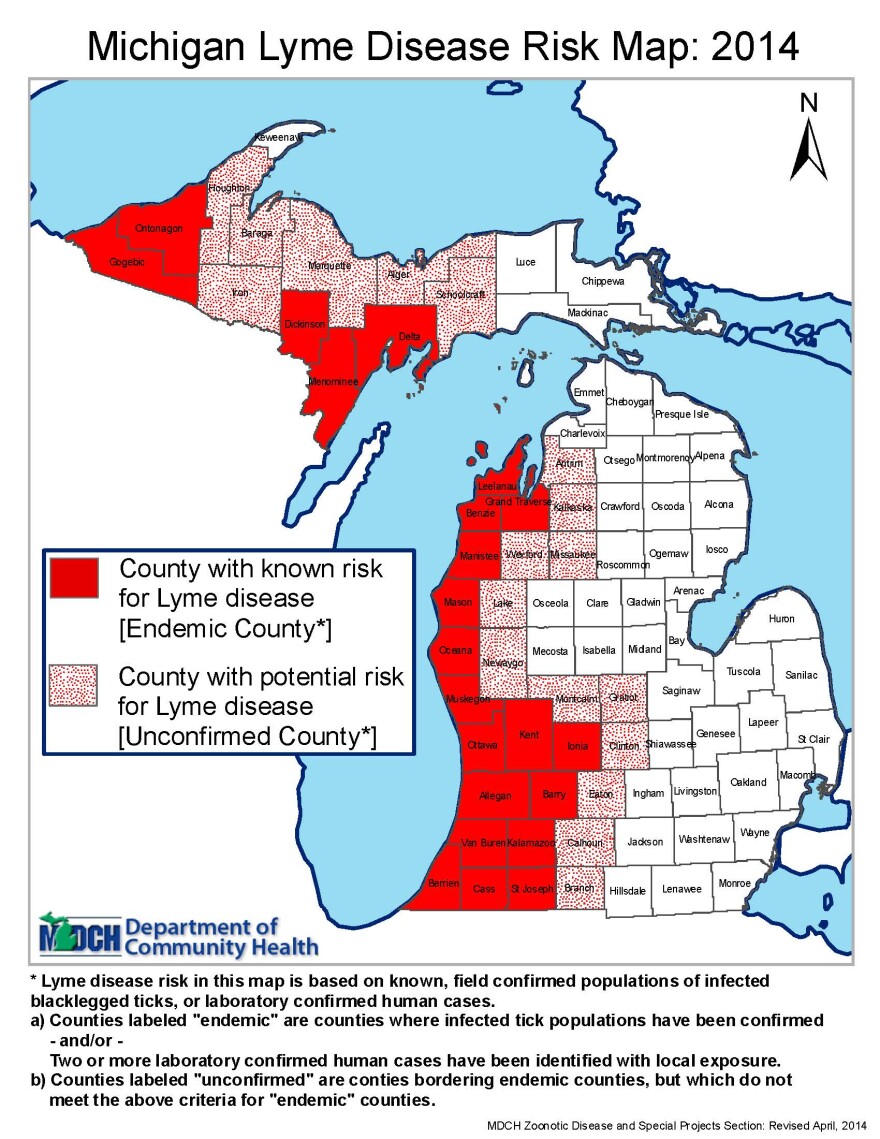As you spread out on the lawn to watch fireworks this Fourth of July, you might pick up a tick or two. Tick-borne illnesses have been on the rise across the country and the tick that is most likely to transmit Lyme disease in our area—the black-legged tick—has seen a population boom in the past few years.
Lyme disease isn't easy to live with, just ask Donna Ross of Kalamazoo.

Ross has been living with Lyme disease for about six years. She’s a former nurse and now co-leads a local Lyme support group.
Ross says it all started when she found a tick on her scalp a few days after visiting her cabin in Baldwin.
“To be honest I didn’t think anything of it. I took it off, went about my business. And about a year and a half later I started to have a very strange assortment of symptoms that nobody could figure out what was wrong with me,” she said.
Symptoms like dizziness, tremors, an irregular heartbeat, and severe weight loss.
Ross says she was diagnosed with everything from multiple sclerosis to depression. Ross went through 19 doctors before she was diagnosed with Lyme.
Treatment involved five years’ worth of antibiotics, sometimes in IVs. She says it took a long time for the worst symptoms to go away. Ross will likely have some symptoms for the rest of her life. Lyme disease can be incurable if it isn’t caught early.
“So I still deal with pain on a daily basis, but it’s manageable now,” she said.

Kim Signs studies patterns in tick diseases for the Michigan Department of Health. She says the black-legged tick is especially fond of counties on Lake Michigan’s shoreline.
“The environment is just very favorable for the tick. There’s plenty of good habitat. There’s plenty of mice and deer and so it’s just a good habitat for them," she said.
"And it happens where a lot of Michiganders spend their summers. So that also can increase our contact with these ticks.”
Richard Keith has a lot of contact with ticks. He’s the director of the Kalamazoo Valley Bird Observatory. He spends a lot of his time picking ticks off of birds and sending them to a lab at Michigan State University.
Keith says the lab has seen a huge increase in black-legged ticks—and ticks in general—in Southwest Michigan.

“In the last couple of years I’ve found 150 approximately where I was finding none working in the same areas before that," he said.
"So weather conditions something has changed in favor of the survivability, breeding of these ticks and allowed their numbers to increase dramatically.”
Two years ago, Keith says he counted about 7,000 ticks at Fort Custer State Park alone.
He says the nymphs or teenage black-legged ticks are especially bad for Lyme because they come out in the summer when we’re most likely to go outside. They’re also about the size of a poppy seed.
“If it were in the small of your back or someplace like that it’s possible that you could not know it was there,” said Keith.
Keith says there’s another tick that could complicate the Lyme disease problem. Ixodesdentatus—sometimes called the rabbit tick—carries new and different strains of the bacteria which causes Lyme disease.
Keith says this tick doesn’t generally bite humans, but it keeps the bacterium in the environment making it available to the black-legged tick—which does bite people.
“We don’t know how that strain might react if it were introduced to the black-legged ticks and then in turn introduced to humans,” he said.
Keith says it could make the disease more harmful or less harmful - we just don't know.
Keith says researchers at Michigan State University are also likely to announce the presence of a new tick in Michigan soon—Ixodes brunneus—which has no common name. Keith says it’s not a danger to humans, but it’s saliva can harm and even kill birds.
Now that you’re terrified to go outdoors, there is some good news. A tick has to be attached for at least 24 hours to transmit Lyme disease.
As for the Powassan virus—an incurable, deadly disease—the Department of Health’s Kim Signs says even with the increase in black-legged ticks, it’s still very rare. They’ve only found 60 cases in the United States in the past 10 years.
If caught early enough, Lyme disease can be treated with a few weeks of antibiotics. There are places you can send the tick to test it for Lyme and some doctors will even write a prescription—just in case.
Donna Ross says doctors need to get better at recognizing tick-borne diseases.
“We kind of have to help each other until better awareness is out there. I think a lot of physicians just really do not know,” said Ross.
The Kalamazoo Lyme Disease Support Group meets every third Monday of the month at 7 p.m. at The Bridge, a church in Portage.

